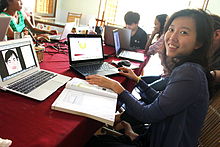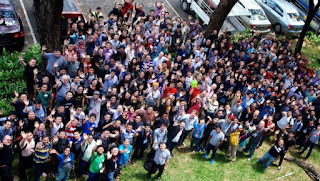FOSSASIA has its headquarters in Singapore, in the NUS Plug-In@Blk71 building.
Projects
Projects of FOSSASIA range from open hardware, to design, graphics and software. The organization offers resources and funding for projects and organizes meetups and code camps.
FOSSASIA Summit
The annual FOSSASIA Summit is the premier Free and Open Source technology event in Asia. It was established in 2009. Previous events took place in Cambodia and Vietnam.
History
The first event organized by the FOSSASIA team was GNOME.Asia in Vietnam in 2009 with 1400 participants and 138 volunteers over three days. 60% of participants were women. The idea of the FOSSASIA Summit is based on the 2009 success.
FOSSASIA - 2010
 |
| Hong Phuc Dang enjoying an Inkscape Workshop at FOSSASIA |
FOSSASIA 2010 was held at Raffles College in Ho Chi Minh City from November 12–14, 2010. The focus of 2010 was "Lightweight Computing and Women in IT". Important Speakers at the event were Jon Phillips, from the Open Clip Art Library and co-founder of Inkscape, Jan Suhr from Crypto-Stick, Pierros Papadeas, developer at Fedora (operating system), Dietrich Ayala, Mozilla developer and Michael Howden from Sahana Eden.
 FOSSASIA - 2011
FOSSASIA - 2011FOSSASIA 2011 was held at Van Lang University in Ho Chi Minh City on November 11–12, 2011. Davide Storti from the UNESCO Open Source Department, Jonas Smedegaard, Developer at Debian, Sven Berg Ryen, from Drupal and Justin Lee, mobile developer and Geekcamp Singapore organizer.
 |
| FOSSASIA community meetup at GNOME.Asia 2012 |
The FOSSASIA Open Design Weeks were held at different locations and times in Vietnam in 2012. The goal of the events was to foster sharing of graphic designs, Libre Graphics, Free and Open Source software, Open Content, FashionTec projects and to feature the maker community. Speakers included Pierre Marchand, Scribus developer and artist, Alexandre Leray, graphic designer, Stephanie Villayphou, media designer and Pierre Huyghebaert, designer of typography and animations and co-founder of Hammerfonts.
 |
| GNOME.Asia Hong Kong 2012 |
FOSSASIA - 2014
FOSSASIA 2014 was held in Phnom Penh, Cambodia on February 28 to March 2, 2014. The event had over 800 attendees, 71 International Speakers, 121 Talks, Workshops and Panels in eight tracks.[4] Speakers at the event included Colin Charles, Community Manager of MariaDB, Cat Allman, Open Source Manager at Google, Dominik Stankowski, board member of the TYPO3 Foundation, Chia-liang Kao from the Open Data community, and Bastian Bittorf from Freifunk.
 |
| FOSSASIA 2015 Singapore - Wrap Up |
FOSSASIA 2015 will take place in Singapore from March 13–15. Speakers include Lennart Poettering, main developer of Pulse Audio and systemd, Kushal Das, Director of the Python Software Foundation, André Rebentisch, board member of the FFII and Julien Lavergne from the Lubuntu project. The topics covered would be smart city and design, big data, and open source software and hardware. FOSSASIA 2015 is sponsored by Google, mySQL and Oracle.
Contributions
FOSSASIA strongly encourages the formation and growth of more open source organizations and programs and has participated in open-source programs such as the Google Summer of Code since 2011 and in Google Code-In since 2014.
External links
FOSSASIA official event website
FOSSASIA Blog
FOSSASIA Community Network
FOSSASIA Summit 2014, Phnom Penh
FOSSASIA Open Design Weeks 2012, Mekong Delta
FOSSASIA Summit 2011, Ho Chi Minh City
FOSSASIA Summit 2010, Ho Chi Minh City
GNOME.Asia 2009
FOSSASIA on Github
Source : wikipedia













